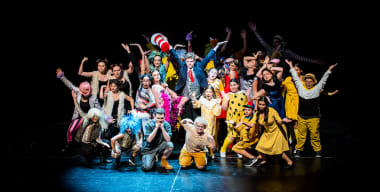Choosing a school for a STEM-oriented child
Exploring a STEM-oriented child's school fit
Students vary widely in their interest in STEM subjects (Science, Technology, Engineering, and Math): while some really enjoy them, others don’t. Your child’s interest in STEM is an important factor in school choice: it can greatly affect the kind of learning environment, and hence school, that’s right for them.
STEM-oriented kids are passionate about at least two STEM subjects (Science, Technology, Engineering, and Math). They really enjoy STEM education and are eager to pursue more in-depth studies.
Below, we identify key points you should reflect on when considering 10 different school types for your STEM-oriented child. Note: our aim isn’t to tell you whether a school type is right or wrong for you, but to highlight some critical factors you should consider when making your decision.
To learn about how to choose the right school in general, read the Our Kids’ step-by-step advice guide and our expert tips. To get school-choice advice customized to your child's unique traits, create a child profile through your user account and read our seven ways to choose a school based on your child's needs (i.e., overall fit, more academic challenge, social struggles, academic struggles, intensive learning interests, university preparation, and special needs.).
STEM-oriented kids’ fit in 10 school types
On this page:
School size
Gender
Curriculum
Living arrangements
School size
Small school (150 students or less)
Small schools tend to have fewer STEM programs, classes, and extracurriculars than bigger schools. Ask what’s available, focusing specifically on your child’s areas of interest and need. For instance, if they’re keen to work on their computer programming skills, find out whether a coding class is offered during or after school, and whether your child is eligible for it. Also, ask how they teach problem-solving, instill creativity and innovation, and use technology.
Of course, since small schools often have smaller classes with plenty of individualized learning and support, they can give your child the freedom to pursue their interest in STEM with close supervision. A smaller student community often means more group work and collaboration, which can enhance learning and stimulate intellectual and creative insights. Smaller schools are also more likely to integrate STEM learning into the general curriculum, something many STEM-oriented kids enjoy.
Just keep in mind the law of diminishing returns regarding class size. While a class of 12 or 15 students can boost engagement, a class of 4 or 5 can reduce it, since there are too few voices and perspectives to generate much meaningful interaction and discussion.
Big school (151+ students)
Since big schools have larger student populations, they often have more STEM programs, classes, and specialty teachers than smaller schools. They also tend to offer more STEM-oriented supplementaries, like after-school robotics classes or field trips to science museums. And, “Due to their large numbers of students, they offer more opportunities for reflection and collaboration with one’s peers, and to learn from the perspectives of different students, in class and out,” say Ann and Karen Wolff of Wolff Educational Services. Having a larger and more diverse pool of students can make it easier to produce valuable insights and have creative breakthroughs.
Ask prospective schools about their class sizes. Smaller classes with plenty of individualized teaching and learning give students more flexibility to pursue their interests in STEM and get one-on-one support to refine their knowledge and skills.
Gender
Coed school
In a coed school, your STEM-oriented child will have opportunities to work with and learn from the experiences of both boys and girls. This can widen their intellectual perspective and enhance their academic development. “Research shows that since boys and girls often approach problems differently, it can be beneficial to bounce ideas off and seek opinions from both genders,” says Stacey Jacobs, educational consultant at Clear Path Educational Consulting.
That said, a coed environment will require your child to negotiate the complexities of boy-girl interactions. Since this can sometimes be a distraction, ask about the social culture at a coed school.
Girls' school
Girls’ schools enable your daughter to pursue her interest in STEM subjects in an environment potentially free of gender stereotypes and false narratives, such as “boys are better than girls at math.” Various studies conducted by the National Association for Choice in Education show that girls, in a girls-only environment, are more likely to explore and excel in traditional boy-centric subjects, such as math and science. Also, without the pressure of opposite-gender dynamics, many girls feel more comfortable aiming high and taking academic risks.
That said, since your daughter won’t be learning with boys, aim to give her opportunities to interact with them outside of school, so he can gain a wider scope of social experiences, where she’ll learn from the perspectives of girls and boys.
Boys' school
Many boys' schools have a special focus on STEM learning. They offer STEM courses and extracurriculars that will enable your son to pursue his passions and refine his skills. Also, in a boys-only school, your STEM-oriented son won’t have to negotiate the complexities of boy-girl interactions in class, which can help him focus on his studies free from some potential distractions.
Just make sure any school you’re considering isn’t too focused on “high energy” boys. While your son may enjoy the group learning opportunities and physical activities offered in a boys-only environment, he may also sometimes prefer to sit quietly and focus on an independent project. Ensure he’ll have ample opportunity to do this. Also, since your son won’t be learning with girls in class, aim to give him opportunities to interact with them outside of school, so he can gain a wider scope of social experiences, where he’ll learn from the perspective of boys and girls.
Curriculum
Montessori school
Montessori schools’ child-centred, self-directed focus gives kids the flexibility to pursue their interests and dive deeply into STEM subjects. Their interdisciplinary and experiential approach to STEM learning will also appeal to many kids. That said, “Ensure any prospective school doesn’t allow students to focus on these subjects to the detriment of others—e.g., focusing on science or math disproportionately, while leaving other academic areas by the wayside,” says Una Malcolm, Director of Bright Light Learners.
Reggio Emilia school
Reggio Emilia schools’ individualized learning approach gives students a lot of flexibility to explore their interests in different subjects such as STEM. Their approach to teaching science, math, and other STEM subjects is inquiry-based and involves lots of hands-on learning and exploration, which many kids find engaging.
That said, the experiential approach to STEM learning doesn’t work for all kids. Some kids may prefer more direct instruction and theoretical analysis in STEM than some Reggio Emilia schools provide. Since Reggio Emilia schools vary in their approach, talk to school directors and staff to gauge whether your child is a good fit.
International Baccalaureate school
Throughout the continuum, the IB programme provides plenty of opportunities for your child to pursue their interests in STEM and develop their skills and knowledge. In fact, how we explore and understand the world is one of the central themes running through the IB Primary Years Programme (PYP). And, the Middle Years Programme (MYP) provides a rigorous education in myriad scientific spheres, including physics, biology, and chemistry. Since many students also relish the opportunity to study these subjects in more depth by taking Higher-Level (rather than Standard-Level) IB courses, ask whether a school offers them.
That said, “Many IB schools are highly academic and can generate significant pressure to excel,” says Una Malcolm, Director of Bright Light Learners. “Some students may find their passion for STEM recede in this setting.”
Language immersion school
Some students may find it challenging to learn STEM subjects in a second language, as immersion schools usually require. Using an unfamiliar language can interfere with their comprehension and progress in STEM studies, which can be frustrating.
Another concern: “Consider curious and independent learners,” says Dona Matthews, education consultant and author of Beyond Intelligence. “They often prefer more scope for exploring their interest in STEM than language immersion schools sometimes allow. For these kids, the best schools are often those that are flexible enough to give them sufficient time to pursue their passions both in school and out. The added challenge of second-language learning can sometimes interfere with this goal and hinder a child’s intellectual and creative development.”
Living arrangements
Boarding school
With large student populations, boarding schools often have more STEM-oriented programs, classes, and specialized staff. They also tend to offer a wider range of extracurriculars for your child to explore their passion for STEM.
Ask what opportunities are available, in class and out, focusing especially on your child’s interests. For instance, if they’re interested in engineering, find out whether the school offers such a class and when. Also, inquire about a school’s class sizes and teaching approach. Often, small- to medium-sized classes with plenty of individualized learning work well, since they give your child the freedom to pursue their interest in STEM with close supervision.
STEM-oriented kids’ school fit: key take-homes
Since big schools have larger student populations, they often have more STEM programs, classes, and supplementaries than smaller schools. Small schools, meanwhile, often have smaller classes with plenty of individualized learning and support, giving your child more freedom to pursue their interest in STEM, with close supervision.
Montessori schools’ child-centred, self-directed focus gives kids the flexibility to pursue their interests and dive deeply into STEM subjects. That said, ensure a school doesn’t allow your child to focus on these subjects to the detriment of others.
The Reggio Emilia approach to teaching science, math, and other STEM subjects is inquiry-based and involves lots of hands-on learning and exploration, which many kids find stimulating.
- Some students may find it challenging to learn STEM subjects in a second language, as many language immersion schools require.









